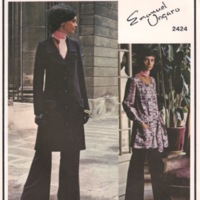An Enduring Legacy
I walked through my sister’s room. Reminders everywhere, but none affected me as intensely as her sneakers. She decided she wouldn’t wear them that day. My mother recounted how nicely dressed she was when she went out for a walk, remarking that she was all in black.
Once upon a time my older sister was a wonder kid. While in her teens she made clothes. With meticulous attention to detail, she cut out patterns, modified them for size, added an under layer even when not called for, and sewed the parts together impeccably. I have a vague recollection of attending a fashion show that included clothes that she made.
Years went by, her life spinning with a negative force she couldn’t control. She decides to end it. Her belongings remain. I took a few of her clothes home. Not the sneakers though, I couldn’t see keeping them; they didn’t fit was the excuse I told myself.
The deep green cotton knit pullover was harder to leave behind. It did fit, and my sister’s essence remained. Every time I put it on I felt her presence, and I kept it for as long as it held that affective power for me. Eventually, it waned and I gave it away. I like to imagine someone else now wearing and enjoying its softness and comfort, or the army green color that mellowed with wash. At its most basic, it provides warmth. I think of a number its qualities that might be appreciated by the wearer, but the personal power it held for me is unique. This does not imply that future wearers won’t develop their own personal connection to this garment.
In addition to store bought, I kept clothes that my sister made. These were buried deep in the back of her closet, painful reminders of a self she no longer recognized. I remember when she made the cornflower blue full length dress to wear to our cousin’s wedding. The work that went into that dress continues to astonish me: a full lining, folds fastidiously gathered and sewed in the pintuck bodice, fabric covered buttons that she hand made, and a thick sash attached to tie in the back. This dress holds an emotional power that is indescribable. When I look at it, feel it, and study its construction I am brought back to a childhood shared with a big sister who inspired a sense of wonder.
Like the blue dress, the long gray coat evokes memories of our past. It is another garment that my sister constructed masterfully in the early/mid 1970s, and the vintage design of its era is notable. I still wear this stylish coat and when I do, I recognize an additional power that it holds for me. I am aware of its materiality, structure, and design elements, and how these affect my demeanor. I carry myself differently when I wear this mod coat, while inwardly I reflect on bittersweet memories of my sister. Peter Stallybrass expressed in his essay the personal and emotional qualities that clothes can imbue. In his, Umberto Eco observed the physical and outward behavior elicited by the wearing of certain clothes. I look at the gray coat that now hangs outside the closet and I am struck by its power, both emotional and physical.
Stallybrass, Peter. "Worn Worlds: Clothes, Mourning, and the Life of Things." The Yale Review, vol 81, no. 1, 1993, pp. 35-50
Eco, Umberto, "Lumbar Thoughts" in Malcom Barnard ed., Fashion Theory: A Reader, London and New York: Routledge, 2007. pp. 315-317







